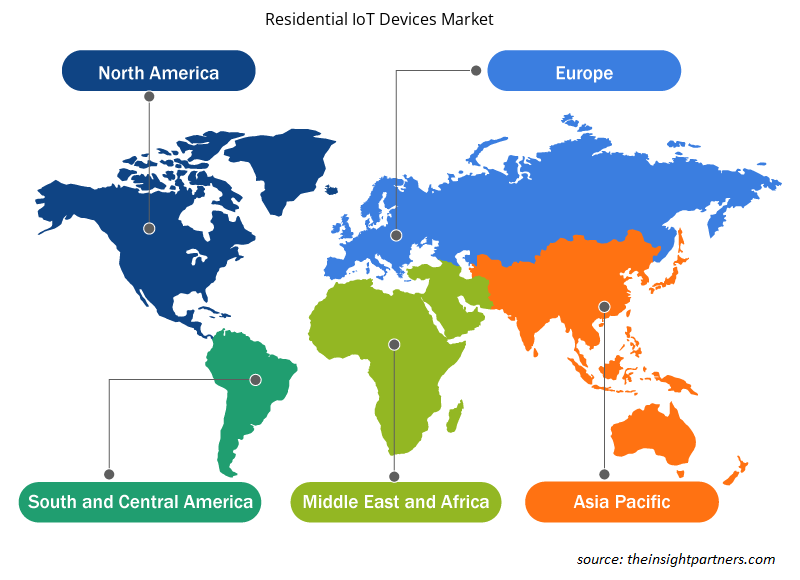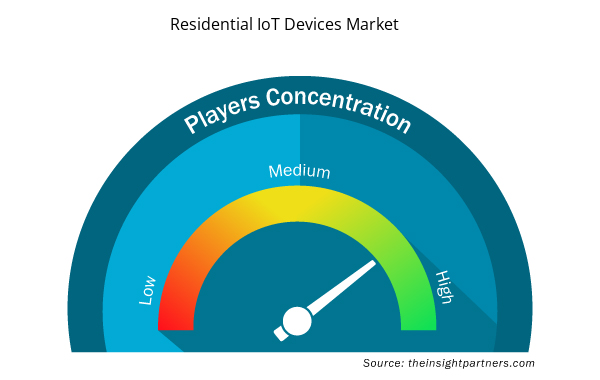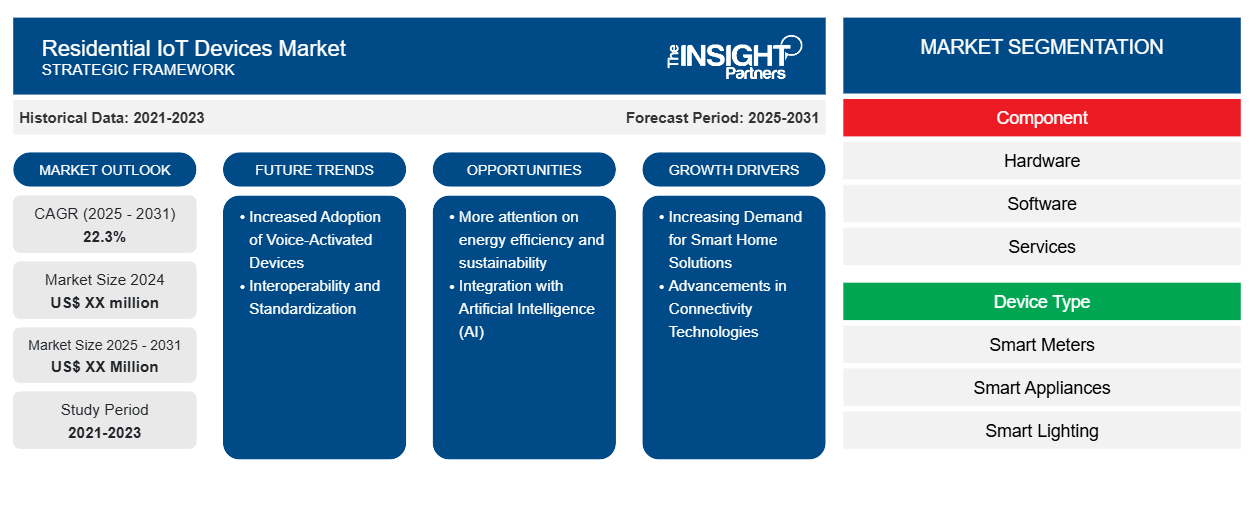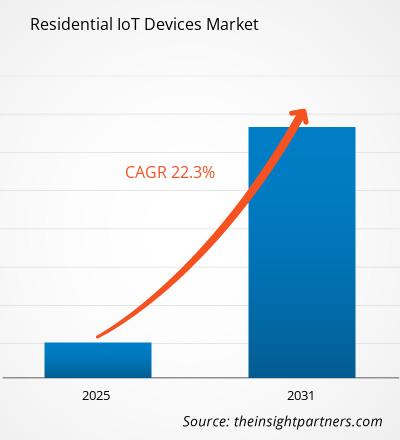Der Markt für IoT-Geräte für Privathaushalte soll von 2023 bis 2031 eine durchschnittliche jährliche Wachstumsrate (CAGR) von 22,3 % verzeichnen, wobei die Marktgröße von XX Millionen US-Dollar im Jahr 2023 auf XX Millionen US-Dollar im Jahr 2031 anwachsen soll.IoT Devices Market is expected to register a CAGR of 22.3% from 2023 to 2031, with a market size expanding from US$ XX million in 2023 to US$ XX Million by 2031.
Der Bericht ist segmentiert nach Komponente [Hardware, Software, Services (Professional Services, Managed Services)]; Gerätetyp (Smart Meter, Smart Appliances, Smart Lighting, Smart Home Gateways, Smart Thermostats, Sonstiges); Geografie (Nordamerika, Europa, Asien-Pazifik, Naher Osten und Afrika, Süd- und Mittelamerika).
Die globale Analyse ist weiter auf regionaler Ebene und in die wichtigsten Länder unterteilt. Der Bericht bietet den Wert in USD für die oben genannte Analyse und SegmenteUSD for the above analysis and segments
Zweck des Berichts
Der Bericht Residential IoT Devices Market von The Insight Partners zielt darauf ab, die aktuelle Landschaft und das zukünftige Wachstum sowie die wichtigsten treibenden Faktoren, Herausforderungen und Chancen zu beschreiben. Dies wird verschiedenen Geschäftspartnern Einblicke geben, wie zum Beispiel:IoT Devices Market by The Insight Partners aims to describe the present landscape and future growth, top driving factors, challenges, and opportunities. This will provide insights to various business stakeholders, such as:
- Technologieanbieter/-hersteller: Um die sich entwickelnde Marktdynamik zu verstehen und die potenziellen Wachstumschancen zu kennen, damit sie fundierte strategische Entscheidungen treffen können.
- Investoren: Durchführung einer umfassenden Trendanalyse hinsichtlich der Marktwachstumsrate, der finanziellen Marktprognosen und der Chancen entlang der Wertschöpfungskette.
- Regulierungsbehörden: Zur Regulierung von Richtlinien und Überwachungsaktivitäten auf dem Markt mit dem Ziel, Missbrauch zu minimieren, das Vertrauen der Anleger zu bewahren und die Integrität und Stabilität des Marktes aufrechtzuerhalten.
Marktsegmentierung für IoT-Geräte für PrivathaushalteIoT Devices Market Segmentation
Komponente
- Hardware
- Software
- Dienstleistungen
Gerätetyp
- Intelligente Zähler
- Intelligente Geräte
- Intelligente Beleuchtung
- Smart Home-Gateways
- Intelligente Thermostate
- Sonstiges
Passen Sie diesen Bericht Ihren Anforderungen an
Sie erhalten kostenlose Anpassungen an jedem Bericht, einschließlich Teilen dieses Berichts oder einer Analyse auf Länderebene, eines Excel-Datenpakets sowie tolle Angebote und Rabatte für Start-ups und Universitäten.
- Holen Sie sich die wichtigsten Markttrends aus diesem Bericht.Dieses KOSTENLOSE Beispiel umfasst eine Datenanalyse von Markttrends bis hin zu Schätzungen und Prognosen.
Wachstumstreiber auf dem Markt für IoT-Geräte für PrivathaushalteIoT Devices Market Growth Drivers
- Steigende Nachfrage nach Smart-Home-Lösungen: Das wachsende Interesse der Verbraucher an Smart-Home-Technologien ist eine der Hauptantriebskräfte hinter dem Markt für IoT-Geräte für Privathaushalte. Komfort, Sicherheit und Energieeffizienz zu Hause haben die Nachfrage der Verbraucher nach Smart-Home-Lösungen angekurbelt. Intelligente Thermostate, Beleuchtungssysteme und Sicherheitskameras werden schnell zu integrierten Bestandteilen moderner Häuser. Dies wird durch die Nachfrage nach einem besseren Home-Environment-Management und der Möglichkeit, Geräte über Smartphones und Sprachassistenten fernzusteuern, angetrieben, was sich positiv auf die zunehmende Nutzung von IoT in Wohnanwendungen ausgewirkt hat.IoT devices market. Convenience, security, and energy efficiency at home have been fueling consumer demand for smart home solutions. Smart thermostats, lighting systems, and security cameras are fast becoming integrated components of modern homes. This is fueled by the demand for better home environment management and the capability to remotely control devices via smartphones and voice assistants, which has positively influenced the rising uptake of IoT in residential applications.
- Fortschritte bei Konnektivitätstechnologien: Die Fortschritte bei Konnektivitätstechnologien wie Wi-Fi 6, Zigbee und Z-Wave rüsten IoT-Geräte in Privathaushalten aus. All diese Technologien ermöglichen ein harmonisches Zusammenspiel der Geräte und sorgen so für mehr Funktionalität und Benutzerfreundlichkeit. Eine bessere Konnektivität integriert mehr als ein Gerät in die Smart-Home-Umgebung und ermöglicht den Verbrauchern so eine bessere Verwaltung des Hauses. Zuverlässigkeit und Allgegenwärtigkeit gehen mit der Erwartung einer zunehmenden Verbreitung von IoT-Geräten einher.Wi-Fi 6, Zigbee, and Z-Wave are equipping residential IoT devices. All these technologies enable equipment to work in a harmonious manner, ensuring greater functionality and usability on behalf of users. Better connectivity integrates more than one device into the smart home environment, and thus makes better management of the house for consumers. Reliability and ubiquity come with an expectation of increased penetration by IoT devices.
Markttrends für IoT-Geräte für PrivathaushalteIoT Devices Market Future Trends
- Zunehmende Nutzung sprachgesteuerter Geräte: Diese werden aufgrund des wachsenden Trends zu virtuellen Assistenten wie Amazon Alexa, Google Assistant und Apple Siri immer häufiger genutzt. Geräte wie diese bieten den zusätzlichen Vorteil von Komfort und Benutzerfreundlichkeit, da sie es dem Benutzer ermöglichen, seine Smart-Home-Systeme über Sprachbefehle zu steuern. Die gestiegene Nachfrage nach sprachgesteuerten IoT-Geräten ist auch auf die rasante Entwicklung der Spracherkennungstechnologie zurückzuführen; bald wird diese Nachfrage noch steigen, da sich die Menschen täglich an Sprachbefehle gewöhnen.Alexa, Google Assistant, and Apple Siri. Devices like these offer an added advantage of convenience and usability because they allow the user to manipulate their smart home systems through voice commands. The increased demand of voice-activated IoT devices is also due to rapid development in speech recognition technology; soon, this will increase as people become accustomed to voice commands every day.
- Interoperabilität und Standardisierung: Da die Anzahl der IoT-Geräte in Wohnumgebungen zunimmt, wird die Interoperabilität zwischen verschiedenen Geräten und Plattformen zu einem wichtigen Trend. Verbraucher möchten, dass Geräte verschiedener Hersteller reibungslos zusammenarbeiten, um ein einheitliches Smart-Home-Erlebnis zu ermöglichen. Unternehmen konzentrieren sich auf die Entwicklung von IoT-Geräten, die gängigen Standards und Protokollen entsprechen, wie Zigbee, Z-Wave und Matter (früher Project Connected Home over IP). Die Standardisierung von IoT-Systemen ermöglicht es Geräten verschiedener Hersteller, miteinander zu kommunizieren, was das Benutzererlebnis verbessert und die weitere Verbreitung von IoT-Technologien in Haushalten vorantreibt.IoT devices in residential settings grows, interoperability between different devices and platforms is becoming a key trend. Consumers want devices from different manufacturers to work together seamlessly, enabling a cohesive smart home experience. Companies are focusing on developing IoT devices that adhere to common standards and protocols, such as Zigbee, Z-Wave, and Matter (formerly Project Connected Home over IP). The standardization of IoT systems enables devices from various manufacturers to communicate with one another, enhancing user experience and driving further adoption of IoT technologies in homes.
Marktchancen für IoT-Geräte für PrivathaushalteIoT Devices Market Opportunities
- Mehr Aufmerksamkeit für Energieeffizienz und Nachhaltigkeit: Angesichts steigender Energiekosten und wachsender Umweltprobleme ist der Bedarf an Energieeffizienz und Nachhaltigkeit in Wohngebieten so hoch wie nie zuvor. IoT-Geräte wie intelligente Zähler und Energiemanagementsysteme ermöglichen es Kunden, ihren Energieverbrauch zu verfolgen und anschließend zu optimieren. Die Geräte liefern dem Benutzer Daten und Einblicke in Echtzeit, sodass er bessere Entscheidungen in Bezug auf den aktuellen Energieverbrauch treffen und so Geld sparen und gleichzeitig den CO2-Fußabdruck verringern kann. Diese Technologie hat daher eine Nachfrage nach IoT-Lösungen für Privathaushalte ausgelöst, die ein nachhaltiges Leben unterstützen.IoT devices such as smart meters and energy management systems enable customers to track and then optimize their energy consumption. The devices offer real-time data and insights to the user so that they can make better decisions in reference to current energy consumption levels, thereby saving them money while reducing carbon footprint. This technology has therefore sparked a demand for home IoT solutions that support sustainable living.
- Integration mit künstlicher Intelligenz (KI): Mit KI in IoT-Geräten für den Heimbereich bietet sich ein riesiger Spielraum für Innovation und Funktionserweiterung. Durch KI können Geräte die Vorlieben des Benutzers lernen, Routinen automatisieren und personalisierte Empfehlungen für ein verbessertes Benutzererlebnis bereitstellen. In einem Szenario, in dem intelligente und intuitive Heimlösungen bei den Verbrauchern gefragt sind, können sich Unternehmen mit KI-basierten IoT-Angeboten von der Konkurrenz abheben.IoT devices. Through AI, devices can learn preferences of the user, automate routines, and provide personalized recommendations for enhanced user experience. In a scenario where smart and intuitive home solutions are in demand by consumers, companies can separate themselves from competition with AI-based IoT offerings.
Regionale Einblicke in den Markt für IoT-Geräte für PrivathaushalteIoT Devices Market Regional Insights
Die regionalen Trends und Faktoren, die den Markt für IoT-Geräte für Privathaushalte im Prognosezeitraum beeinflussen, wurden von den Analysten von Insight Partners ausführlich erläutert. In diesem Abschnitt werden auch die Marktsegmente und die Geografie für IoT-Geräte für Privathaushalte in Nordamerika, Europa, im asiatisch-pazifischen Raum, im Nahen Osten und Afrika sowie in Süd- und Mittelamerika erörtert.IoT Devices Market throughout the forecast period have been thoroughly explained by the analysts at Insight Partners. This section also discusses Residential IoT Devices Market segments and geography across North America, Europe, Asia Pacific, Middle East and Africa, and South and Central America.

- Erhalten Sie regionale Daten zum Markt für IoT-Geräte für Privathaushalte
Umfang des Marktberichts zu IoT-Geräten für Privathaushalte
| Berichtsattribut | Details |
|---|---|
| Marktgröße im Jahr 2023 | XX Millionen US-Dollar |
| Marktgröße bis 2031 | XX Millionen US-Dollar |
| Globale CAGR (2023 - 2031) | 22,3 % |
| Historische Daten | 2021-2022 |
| Prognosezeitraum | 2024–2031 |
| Abgedeckte Segmente | Nach Komponente
|
| Abgedeckte Regionen und Länder | Nordamerika
|
| Marktführer und wichtige Unternehmensprofile |
|
Dichte der Marktteilnehmer für IoT-Geräte für Privathaushalte: Auswirkungen auf die Geschäftsdynamik verstehen
Der Markt für IoT-Geräte für Privathaushalte wächst rasant. Dies wird durch die steigende Nachfrage der Endnutzer aufgrund von Faktoren wie sich entwickelnden Verbraucherpräferenzen, technologischen Fortschritten und einem größeren Bewusstsein für die Vorteile des Produkts vorangetrieben. Mit der steigenden Nachfrage erweitern Unternehmen ihr Angebot, entwickeln Innovationen, um die Bedürfnisse der Verbraucher zu erfüllen, und nutzen neue Trends, was das Marktwachstum weiter ankurbelt.
Die Marktteilnehmerdichte bezieht sich auf die Verteilung von Firmen oder Unternehmen, die in einem bestimmten Markt oder einer bestimmten Branche tätig sind. Sie gibt an, wie viele Wettbewerber (Marktteilnehmer) in einem bestimmten Marktraum im Verhältnis zu seiner Größe oder seinem gesamten Marktwert präsent sind.
Die wichtigsten Unternehmen auf dem Markt für IoT-Geräte für Privathaushalte sind:
- Amazon.com, Inc.
- Bosch.IO GmbH (Robert Bosch GmbH)
- Ökobiene
- Google, LLC
- Honeywell International Inc.
Haftungsausschluss : Die oben aufgeführten Unternehmen sind nicht in einer bestimmten Reihenfolge aufgeführt.

- Überblick über die wichtigsten Akteure auf dem Markt für IoT-Geräte für Privathaushalte
Wichtige Verkaufsargumente
- Umfassende Abdeckung: Der Bericht deckt die Analyse von Produkten, Diensten, Typen und Endbenutzern des Marktes für IoT-Geräte für Privathaushalte umfassend ab und bietet einen ganzheitlichen Überblick.
- Expertenanalyse: Der Bericht basiert auf dem umfassenden Verständnis von Branchenexperten und Analysten.
- Aktuelle Informationen: Der Bericht stellt durch die Abdeckung aktueller Informationen und Datentrends Geschäftsrelevanz sicher.
- Anpassungsoptionen: Dieser Bericht kann angepasst werden, um spezifische Kundenanforderungen zu erfüllen und die Geschäftsstrategien optimal anzupassen.
Der Forschungsbericht zum Markt für IoT-Geräte für Privathaushalte kann daher dabei helfen, die Branchensituation und Wachstumsaussichten zu entschlüsseln und zu verstehen. Obwohl es einige berechtigte Bedenken geben kann, überwiegen die allgemeinen Vorteile dieses Berichts tendenziell die Nachteile.
- Historische Analyse (2 Jahre), Basisjahr, Prognose (7 Jahre) mit CAGR
- PEST- und SWOT-Analyse
- Marktgröße Wert/Volumen – Global, Regional, Land
- Branche und Wettbewerbsumfeld
- Excel-Datensatz



Report Coverage
Revenue forecast, Company Analysis, Industry landscape, Growth factors, and Trends

Segment Covered
This text is related
to segments covered.

Regional Scope
North America, Europe, Asia Pacific, Middle East & Africa, South & Central America

Country Scope
This text is related
to country scope.
Häufig gestellte Fragen
Some of the customization options available based on the request are an additional 3-5 company profiles and country-specific analysis of 3-5 countries of your choice. Customizations are to be requested/discussed before making final order confirmation# as our team would review the same and check the feasibility
The report can be delivered in PDF/PPT format; we can also share excel dataset based on the request
Increased Adoption of Voice-Activated Devices is anticipated to play a significant role in the global Residential IoT Devices Market in the coming years
Increasing Demand for Smart Home Solutions and Advancements in Connectivity Technologies are the major factors driving the Residential IoT Devices Market
The Residential IoT Devices Market is estimated to witness a CAGR of 22.3% from 2023 to 2031
Trends and growth analysis reports related to Electronics and Semiconductor : READ MORE..
1.Amazon.com, Inc.
2.Bosch.IO GmbH (Robert Bosch GmbH)
3.ecobee
4.Google, LLC
5.Honeywell International Inc.
6.LG Electronics
7.Qualcomm Technologies, Inc.
8.Radio Thermostat Company of America
9.Samsung
10.Signify Holding
The Insight Partners performs research in 4 major stages: Data Collection & Secondary Research, Primary Research, Data Analysis and Data Triangulation & Final Review.
- Data Collection and Secondary Research:
As a market research and consulting firm operating from a decade, we have published and advised several client across the globe. First step for any study will start with an assessment of currently available data and insights from existing reports. Further, historical and current market information is collected from Investor Presentations, Annual Reports, SEC Filings, etc., and other information related to company’s performance and market positioning are gathered from Paid Databases (Factiva, Hoovers, and Reuters) and various other publications available in public domain.
Several associations trade associates, technical forums, institutes, societies and organization are accessed to gain technical as well as market related insights through their publications such as research papers, blogs and press releases related to the studies are referred to get cues about the market. Further, white papers, journals, magazines, and other news articles published in last 3 years are scrutinized and analyzed to understand the current market trends.
- Primary Research:
The primarily interview analysis comprise of data obtained from industry participants interview and answers to survey questions gathered by in-house primary team.
For primary research, interviews are conducted with industry experts/CEOs/Marketing Managers/VPs/Subject Matter Experts from both demand and supply side to get a 360-degree view of the market. The primary team conducts several interviews based on the complexity of the markets to understand the various market trends and dynamics which makes research more credible and precise.
A typical research interview fulfils the following functions:
- Provides first-hand information on the market size, market trends, growth trends, competitive landscape, and outlook
- Validates and strengthens in-house secondary research findings
- Develops the analysis team’s expertise and market understanding
Primary research involves email interactions and telephone interviews for each market, category, segment, and sub-segment across geographies. The participants who typically take part in such a process include, but are not limited to:
- Industry participants: VPs, business development managers, market intelligence managers and national sales managers
- Outside experts: Valuation experts, research analysts and key opinion leaders specializing in the electronics and semiconductor industry.
Below is the breakup of our primary respondents by company, designation, and region:

Once we receive the confirmation from primary research sources or primary respondents, we finalize the base year market estimation and forecast the data as per the macroeconomic and microeconomic factors assessed during data collection.
- Data Analysis:
Once data is validated through both secondary as well as primary respondents, we finalize the market estimations by hypothesis formulation and factor analysis at regional and country level.
- Macro-Economic Factor Analysis:
We analyse macroeconomic indicators such the gross domestic product (GDP), increase in the demand for goods and services across industries, technological advancement, regional economic growth, governmental policies, the influence of COVID-19, PEST analysis, and other aspects. This analysis aids in setting benchmarks for various nations/regions and approximating market splits. Additionally, the general trend of the aforementioned components aid in determining the market's development possibilities.
- Country Level Data:
Various factors that are especially aligned to the country are taken into account to determine the market size for a certain area and country, including the presence of vendors, such as headquarters and offices, the country's GDP, demand patterns, and industry growth. To comprehend the market dynamics for the nation, a number of growth variables, inhibitors, application areas, and current market trends are researched. The aforementioned elements aid in determining the country's overall market's growth potential.
- Company Profile:
The “Table of Contents” is formulated by listing and analyzing more than 25 - 30 companies operating in the market ecosystem across geographies. However, we profile only 10 companies as a standard practice in our syndicate reports. These 10 companies comprise leading, emerging, and regional players. Nonetheless, our analysis is not restricted to the 10 listed companies, we also analyze other companies present in the market to develop a holistic view and understand the prevailing trends. The “Company Profiles” section in the report covers key facts, business description, products & services, financial information, SWOT analysis, and key developments. The financial information presented is extracted from the annual reports and official documents of the publicly listed companies. Upon collecting the information for the sections of respective companies, we verify them via various primary sources and then compile the data in respective company profiles. The company level information helps us in deriving the base number as well as in forecasting the market size.
- Developing Base Number:
Aggregation of sales statistics (2020-2022) and macro-economic factor, and other secondary and primary research insights are utilized to arrive at base number and related market shares for 2022. The data gaps are identified in this step and relevant market data is analyzed, collected from paid primary interviews or databases. On finalizing the base year market size, forecasts are developed on the basis of macro-economic, industry and market growth factors and company level analysis.
- Data Triangulation and Final Review:
The market findings and base year market size calculations are validated from supply as well as demand side. Demand side validations are based on macro-economic factor analysis and benchmarks for respective regions and countries. In case of supply side validations, revenues of major companies are estimated (in case not available) based on industry benchmark, approximate number of employees, product portfolio, and primary interviews revenues are gathered. Further revenue from target product/service segment is assessed to avoid overshooting of market statistics. In case of heavy deviations between supply and demand side values, all thes steps are repeated to achieve synchronization.
We follow an iterative model, wherein we share our research findings with Subject Matter Experts (SME’s) and Key Opinion Leaders (KOLs) until consensus view of the market is not formulated – this model negates any drastic deviation in the opinions of experts. Only validated and universally acceptable research findings are quoted in our reports.
We have important check points that we use to validate our research findings – which we call – data triangulation, where we validate the information, we generate from secondary sources with primary interviews and then we re-validate with our internal data bases and Subject matter experts. This comprehensive model enables us to deliver high quality, reliable data in shortest possible time.


 Holen Sie sich ein kostenloses Muster für diesen Bericht
Holen Sie sich ein kostenloses Muster für diesen Bericht